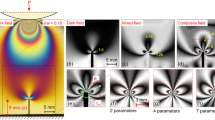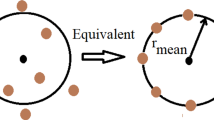Abstract
A numerical study of the parameters influencing the accuracy of computed stress intensity factor (SIF) values is presented in this article. Mode I SIFs of a through-thickness center crack are calculated by employing the displacement extrapolation method (DEM) of near-tip field extrapolation and the energy-based interaction integral method (IIM). The results are compared with an analytical solution, and some recommendations are provided to increase the accuracy of the calculated mode I SIFs. Optimized influencing parameters can minimize the errors obtained with DEM, whereas the errors obtained with IIM are negligible for a variety of crack lengths. Based on the recommendations made for the mode I SIF calculation, assessment of the mode I and mode II SIFs is performed at the weld root crack tip of a load-carrying cruciform fillet welded joint loaded under a three-point bending condition. The accuracy of the mode I SIF calculated with DEM is independent of the crack length, whereas that of mode II is highly dependent. The IIM provides accurate SIFs for both modes for various crack lengths.














Similar content being viewed by others
Abbreviations
- a :
-
Crack length (mm)
- A :
-
Area inside the contour (m2)
- b :
-
Half specimen width (mm)
- \(e_{K}\) :
-
Percent difference (%)
- E :
-
Elastic modulus (GPa)
- \(E^{\prime }\) :
-
Effective elastic modulus (GPa)
- F :
-
Bending load (kN)
- G :
-
Shear modulus (GPa)
- h :
-
Half specimen height (mm)
- I :
-
Interaction integral (MPa m)
- J :
-
J-integral (MPa m)
- \(K_{\text{eq}}\) :
-
Equivalent stress intensity factor (MPa m1/2)
- \(K_{\text{I}} ,K_{\text{II}}\) :
-
Mode I and mode II stress intensity factors (MPa m1/2)
- L :
-
Element size (mm)
- \(L_{\text{B}}\) :
-
Element size in the body (mm)
- \(L_{\text{T}}\) :
-
Element size around the crack tip (mm)
- \(L_{\text{B}} /L_{\text{T}}\) :
-
Mesh size ratio
- n :
-
Angular discretization around the crack tip
- q :
-
Weight function in the domain integral
- t :
-
Plate thickness (mm)
- W :
-
Strain energy density (J/m3)
- Y :
-
Geometry factor
- (u, v):
-
Displacements parallel and perpendicular to the crack growth direction
- (r, θ):
-
Polar coordinates with the origin at the crack tip
- \(\alpha\) :
-
Crack length dimensionless parameter
- \(\kappa\) :
-
Elastic parameter
- \(\nu\) :
-
Poisson’s ratio
- \(\sigma\) :
-
Tensile stress (MPa)
References
P.C. Paris, F. Erdogan, A critical analysis of crack propagation laws. Trans. ASME J. Basic Eng. 85, 528–534 (1963)
Y. Murakami, Stress Intensity Factors Handbook (Pergamon Press, Oxford, 1987)
H. Tada, P.C. Paris, G.R. Irwin, The Stress Analysis of Cracks Handbook, 3rd edn. (ASME Press, New York, 2000)
BS 7910, Guide to Methods for Assessing the Acceptability of Flaws in Metallic Structures (British Standard Institution, London, 2005)
M. Isida, Effect of width and length on stress intensity factors of internally cracked plates under various boundary conditions. Int. J. Fract. Mech. 7(3), 301–316 (1971)
M. Aliha, H. Gharehbaghi, R. Ghafoori Ahangar, Fracture study of a welded aluminum cylinder containing longitudinal crack and subjected to combined residual stress and internal pressure, in 12th International Aluminum Conference, Paper No. 62, Montreal, Canada (2013)
V. Sivakumar, K.P. Dani, S. Sriram, Prediction of stress intensity factor on precracked composite wing rib made up of carbon-epoxy IM7-8552. J. Fail. Anal. Prev. 16, 635–646 (2016)
M.A. Bouchelarm, M. Mazari, N. Benseddiq, Stress intensity factor K I and T-stress determination in HDPE material. J. Fail. Anal. Prev. 17, 919–934 (2017)
Q. Han, Y. Wang, Y. Yin, D. Wang, Determination of stress intensity factor for mode I fatigue crack based on finite element analysis. Eng. Fract. Mech. 138, 118–126 (2015)
G. Qian, V. González-Albuixech, M. Niffenegger, E. Giner, Comparison of K I calculation methods. Eng. Fract. Mech. 156, 52–67 (2016)
B. Zafošnik, G. Fajdiga, Determining stress intensity factor K I with extrapolation method. Teh. Vjesn. Sveuc. Osijeku 23(6), 1673–1678 (2016)
I. Lim, I. Johnston, S. Choi, Comparison between various displacement-based stress intensity factor computation techniques. Int. J. Fract. 58, 193–210 (1992)
G.V. Guinea, J. Planas, M. Elices, K I evaluation by the displacement extrapolation technique. Eng. Fract. Mech. 66, 243–255 (2000)
X.K. Zhu, B.N. Leis, Effective methods to determine stress intensity factors for 2D and 3D cracks, in 10th International Pipeline Conference, Calgary, Canada (ASME, 2014)
S. Courtin, C. Gardin, G. Bezine, H.B.H. Hamouda, Advantages of the J-integral approach for calculating stress intensity factors when using the commercial finite element software ABAQUS. Eng. Fract. Mech. 72, 2174–2185 (2005)
L. Banks-Sills, D. Sherman, Comparison of methods for calculating stress intensity factors with quarter-point elements. Int. J. Fract. 32, 127–140 (1986)
P. Fu, S.M. Johnson, R.R. Settgast, C.R. Carrigan, Generalized displacement correlation method for estimating stress intensity factors. Eng. Fract. Mech. 88, 90–107 (2012)
ANSYS, Structural Analysis Guide, Chapter 12: Fracture Mechanics. Release 14.5 (2013)
P.C. Paris, G.C. Sih, Stress analysis of cracks. Fracture toughness testing and its applications. ASTM STP381, 30–83 (1965)
R.S. Barsoum, Application of quadratic isoparametric finite elements in linear fracture mechanics. Int. J. Fract. 10, 603–605 (1974)
J.R. Rice, A path independent integral and the approximate analysis of strain concentration by notches and cracks. Trans. ASME J. Appl. Mech. 35, 379–386 (1968)
C. Shih, B. Moran, T. Nakamura, Energy release rate along a three-dimensional crack front in a thermally stressed body. Int. J. Fract. 30, 79–102 (1986)
J. Yau, S. Wang, H. Corten, A mixed-mode crack analysis of isotropic solids using conservation laws of elasticity. Trans. ASME J. Appl. Mech. 47, 335–341 (1980)
J.E. Noblett, R.M. Andrews, A Stress Intensity Factor Solution for Root Defects in Fillet and Partial Penetration Welds. Fatigue-Core Research from TWI (Abington Publishing, Nashville, 2000), pp. 120–144
A.K. Motarjemi, A. Kokabi, A. Ziaie, S. Manteghi, F. Burdekin, Comparison of the stress intensity factor of T and cruciform welded joints with different main and attachment plate thickness. Eng. Fract. Mech. 65, 55–66 (2000)
J.M. Djoković, R.R. Nikolić, Influence of the joint geometry on the stress intensity factor of the fillet welded cruciform joint subjected to tension and bending. Mater. Today Proc. 3, 959–964 (2016)
Acknowledgments
This work was supported by the Consortium de Recherche en Fabrication et Réparation des Roues d’Eau (CReFaRRE), the Natural Sciences and Engineering Research Council of Canada (NSERC), General Electric Renewable Energy, Hydro-Québec, and the Mathematics of Information Technology and Complex Systems (MITACS).
Author information
Authors and Affiliations
Corresponding author
Rights and permissions
About this article
Cite this article
Ghafoori Ahangar, R., Verreman, Y. Assessment of Mode I and Mode II Stress Intensity Factors Obtained by Displacement Extrapolation and Interaction Integral Methods. J Fail. Anal. and Preven. 19, 85–97 (2019). https://doi.org/10.1007/s11668-018-0571-9
Received:
Published:
Issue Date:
DOI: https://doi.org/10.1007/s11668-018-0571-9




